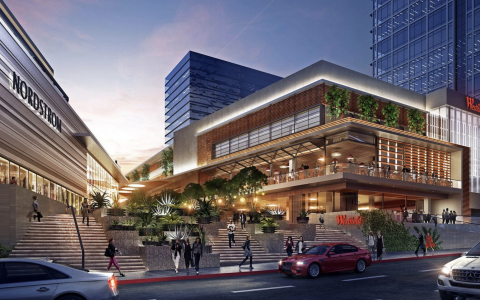
Shopping malls have been through a lot in recent years, combatting waning foot traffic and vacancies amid the so-called retail apocalypse. Now, mall owners are being forced to contend with another unwelcome factor: the coronavirus.
According to data from Cowen, foot traffic in stores for the week ended Friday, March 13, was down 30.7% year over year. And that was before the widespread temporary closure of fashion and other “nonessential” retailers. Ready-to-wear brands and department stores alike have either chosen or were forced to temporarily close all of their locations, a move that will almost certainly result in lower comp-store sales and could force some already struggling retailers out of business.
“I think [this situation] will continue for a while, and all retail stores will be at risk, including malls. The ones that are on the bubble will suffer the most,” said Farla Efros, president, HRC Retail Advisory.
According to Reis Inc., the U.S. retail vacancy rate was 10.2%, as of the fourth quarter of 2019. And as Americans stay home for now amid escalating coronavirus concerns, it goes without saying that malls are one of the last places they want to visit. A Coresight survey conducted this month found that 72% of respondents will avoid malls if the outbreak worsens, with about 64% avoiding all shops.
Jessica Ramirez, retail research analyst at Jane Hali & Associates, said the coronavirus crisis is likely to hit already struggling players the hardest. In that regard, it could help clean up the overstored landscape, one of the factors experts say contributed to the retail apocalypse in the first place.
“In the U.S. in particular, we are overstored. We don’t need as many stores as we have. Even now, after all the closures we’ve seen over the past years, we are still overstored. So, if you see store closures, it’s not necessarily a bad thing,” Ramirez said.
With people avoiding shopping centers and stores in general, the shift away from brick-and-mortar and toward e-commerce could become more rapid, according to Efros.
“I think as the outcome of all this, we will see more bankruptcies, more closures, and online now will continue to grow and [take] a greater share of the pie,” she explained.
The International Council of Shopping Centers, the global trade association of shopping centers and retail real estate, is bracing for the financial impact of widespread closures.In a letter last week addressed to President Donald Trump, Vice President Mike Pence and Treasury Secretary Steven Mnuchin, the ICSC asked the federal government to guarantee or directly provide business interruption coverage for commercial tenants as well as landlords.
“Without ensuring the stability of our tenant base, the repayment of up to $1 trillion in secured and unsecured debt underlying the shopping center industry will be at risk,” wrote ICSC CEO Tom McGee. “This will jeopardize the entire industry and cause long-term damage to financial markets, rampant unemployment and irreparable harm to communities across our country.”
In addition to individual retailers shutting their fleets for now, the nation’s largest mall owner, Simon Property Group, last Wednesday announced its decision to close all locations through at least March 29. Triple Five Group has temporarily shut down the Mall of America in Minnesota and delayed the opening of American Dream in New Jersey. Plus, several states have ordered the closure of all shopping malls, including New York, Pennsylvania, New Jersey and Maryland.
During this temporary shutdown, Efros said all retail tenants will likely ask for either reduced rent, no rent or deferred payments. Ramirez said that landlords, though, will likely to try to pitch in.
“I have a feeling — I’m not completely sure — but I think there’d be some sort of agreements to work [together], especially if the malls themselves are closing. … If you’re closing your stores and you’re not making any money, it’s hard to ask [those retailers] for a follow-up,” she said.
It wouldn’t be the first time mall owners have been compelled to help their ailing tenants amid tough times: In 2016, Simon partnered with mall owner General Growth Properties — now owned by Brookfield — to save then-bankrupt teen mall staple Aeropostale from liquidation. Just this year, Simon was part of a consortium of buyers, which included Authentic Brands Group and Brookfield Property Partners, that acquired Forever 21 and saved it from possible liquidation.
Ramirez said that retailers with robust omnichannel capabilities, such as Dicks Sporting Goods, Target and Walmart, will likely be in the best position to weather the coronavirus pandemic. Some brands which have announced closures, such as Nike and Lululemon, probably have their inventory “in a good place,” she said. But the virus could be more bad news for already-struggling department stores, which often are the anchor tenants of malls.
“If you look at Macy’s, I don’t think their inventory’s in line. Stores like JCPenney probably aren’t either. If your inventory is messed up and if you’ve been locked down for two weeks, I don’t know if that’s going to be anything positive,” Ramirez said. “The department stores, for a while, have not been listening to their consumer and have kind of been digging their own hole.”
But filling a JCPenney or Macy’s-size hole isn’t always an easy feat for mall landlords. Amid past closures, some owners have found tenants in businesses such as Planet Fitness, Whole Foods and IKEA, which can take up large units. Ultimately, the coronavirus crisis could potentially accelerate the current modernization of malls, which has seen shopping centers become increasingly focused on entertainment, direct-to-consumer and pop-ups.
“I think [projects like pop-ups are] the way forward,” Sandy Sigal, CEO and president of NewMark Merrill, an owner of malls throughout California, Colorado and Illinois, told FNin 2019. “The modern center will be like a museum, with standard exhibits and revolving exhibits: your anchor stores and your seasonal or temporary stores.”
This article originally appeared on Yahoo! Finance.



